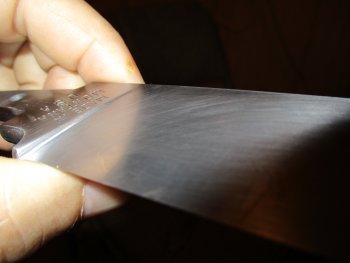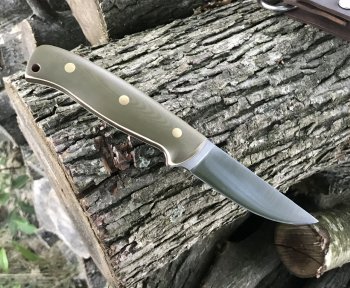You are using an out of date browser. It may not display this or other websites correctly.
You should upgrade or use an alternative browser.
You should upgrade or use an alternative browser.
Heat treatment or geometry, which is more important?
- Thread starter Kevin R. Cashen
- Start date
Smallshop
KNIFE MAKER
I think about the only way to really "see" the geometry is observing the plunge line area.(as far as photos are concerned) generally what you see there is indicative of the rest of the blade.
As to geometry... I have been experimenting with convex blade shapes for the short Bowie I have been working on. Here's some things I think are true...anyone please kick holes in my logic if you have experimented and discovered something different...or if I am making incorrect assumptions.
Convex means a domed shape....but less is more..lol. (this took me longer to learn than it should have...)
If you convex the entire blade the tangent point(high point of the dome) should be at the spine. This allows you to have a less severe convex. Why is this important? Too much belly on the convex will not slice...period. It quickly becomes an axe. Strong and good for only clubbing things apart.
I actually try to hold the spine off the belt a little when shaping until I am using the finer belts. I do not want any drop(or back radius above the tangent point) up near the spine as that robs me of a more gentle curve...(meaning you just shortened the width of the blade for all practical purposes.)
blade thickness has a lot to do with the performance of the convex. If you have two blades with exact profiles and one is 1/4 thick and the other is 1/8 thick and you have the exact same radius of convex they will perform differently. One will be more of a wedge and the other a slicer even though the convex is the same.
A very subtle convex seems much stronger than similar a flat grind. I do not know exactly why.
A convex seems to release food easier when using in the kitchen. perhaps the surface not truly being flat does not allow for the suction effect?
At first grinding a convex felt too loosy goosy on the grinder...I think it may actually be an easier grind once I get used to using a slack belt? I slowed belt speed way down so I could see what is happening and it helps a lot...now starting to speed things up.
try to keep the radius consistent across the width of the blade. It is much easier to sharpen...and you are not introducing variables into the blade performance. You can check consistency by grinding your preferred shape on a short piece of same width/thickness. then mark off a line with dots every .100 or so. using a drop indicator you can cart the curve from spine to edge. using that piece as a standard you mark the blade the same and measure with the drop indicator also. obviously the goal is similar numbers at each mark. This keep you from making different blades when you are trying to repeat a blade with proven performance. It is very easy to have two similarly profiled blades that behave entirely different if you do not have consistent convexes from blade to blade.
I have not tried this with a flat ground blade...cause it's flat...lol.
below is the convex shape I've settled on...it seems to cut well...and seems to be very strong. 1/4 thick and 1.5 tall.
As to geometry... I have been experimenting with convex blade shapes for the short Bowie I have been working on. Here's some things I think are true...anyone please kick holes in my logic if you have experimented and discovered something different...or if I am making incorrect assumptions.
Convex means a domed shape....but less is more..lol. (this took me longer to learn than it should have...)
If you convex the entire blade the tangent point(high point of the dome) should be at the spine. This allows you to have a less severe convex. Why is this important? Too much belly on the convex will not slice...period. It quickly becomes an axe. Strong and good for only clubbing things apart.
I actually try to hold the spine off the belt a little when shaping until I am using the finer belts. I do not want any drop(or back radius above the tangent point) up near the spine as that robs me of a more gentle curve...(meaning you just shortened the width of the blade for all practical purposes.)
blade thickness has a lot to do with the performance of the convex. If you have two blades with exact profiles and one is 1/4 thick and the other is 1/8 thick and you have the exact same radius of convex they will perform differently. One will be more of a wedge and the other a slicer even though the convex is the same.
A very subtle convex seems much stronger than similar a flat grind. I do not know exactly why.
A convex seems to release food easier when using in the kitchen. perhaps the surface not truly being flat does not allow for the suction effect?
At first grinding a convex felt too loosy goosy on the grinder...I think it may actually be an easier grind once I get used to using a slack belt? I slowed belt speed way down so I could see what is happening and it helps a lot...now starting to speed things up.
try to keep the radius consistent across the width of the blade. It is much easier to sharpen...and you are not introducing variables into the blade performance. You can check consistency by grinding your preferred shape on a short piece of same width/thickness. then mark off a line with dots every .100 or so. using a drop indicator you can cart the curve from spine to edge. using that piece as a standard you mark the blade the same and measure with the drop indicator also. obviously the goal is similar numbers at each mark. This keep you from making different blades when you are trying to repeat a blade with proven performance. It is very easy to have two similarly profiled blades that behave entirely different if you do not have consistent convexes from blade to blade.
I have not tried this with a flat ground blade...cause it's flat...lol.
below is the convex shape I've settled on...it seems to cut well...and seems to be very strong. 1/4 thick and 1.5 tall.

John Wilson
Well-Known Member
A full convex blade is an Axe grind. Aside from a blade meant to be a bone chopper I don’t see any value in this.
A convex edge, on the other hand, is absolutely a great performer from both a slicing and durability perspective. A full height flat grind with a micro convex edge works fantastically on every knife I’ve done it on. If a blade need to be an ultra-sharp slicer then the blade is made thinner, and vise versa for a blade that needs more durability.
A convex edge, on the other hand, is absolutely a great performer from both a slicing and durability perspective. A full height flat grind with a micro convex edge works fantastically on every knife I’ve done it on. If a blade need to be an ultra-sharp slicer then the blade is made thinner, and vise versa for a blade that needs more durability.
tkroenlein
Well-Known Member
For those looking at my blade, the convexity is only the first 1/4" from the edge.
Bruce McLeish
Well-Known Member
How would you create said micro convex edge using my primitive tools?A full convex blade is an Axe grind. Aside from a blade meant to be a bone chopper I don’t see any value in this.
A convex edge, on the other hand, is absolutely a great performer from both a slicing and durability perspective. A full height flat grind with a micro convex edge works fantastically on every knife I’ve done it on. If a blade need to be an ultra-sharp slicer then the blade is made thinner, and vise versa for a blade that needs more durability.
tkroenlein
Well-Known Member
Sand paper and a soft backer. And lots...lots of elbow grease.
Bruce McLeish
Well-Known Member
gottem covered.Sand paper and a soft backer. And lots...lots of elbow grease.
John Wilson
Well-Known Member
gottem covered.
a Harbor Freight 1x30 belt sander will change your life. It’s the best sharpening system on the planet (if you don’t have a fully kitted out knife shop.)
I’ve had several of them. I always end up giving it away to help someone else get started. then i miss it too much and go get another one. it’s just a fantastic versatile tool when you don’t need a 2x72.
Bruce McLeish
Well-Known Member
I'm just starting .... Where's mine ? I'll send you my address !a Harbor Freight 1x30 belt sander will change your life. It’s the best sharpening system on the planet (if you don’t have a fully kitted out knife shop.)
I’ve had several of them. I always end up giving it away to help someone else get started. then i miss it too much and go get another one. it’s just a fantastic versatile tool when you don’t need a 2x72.

